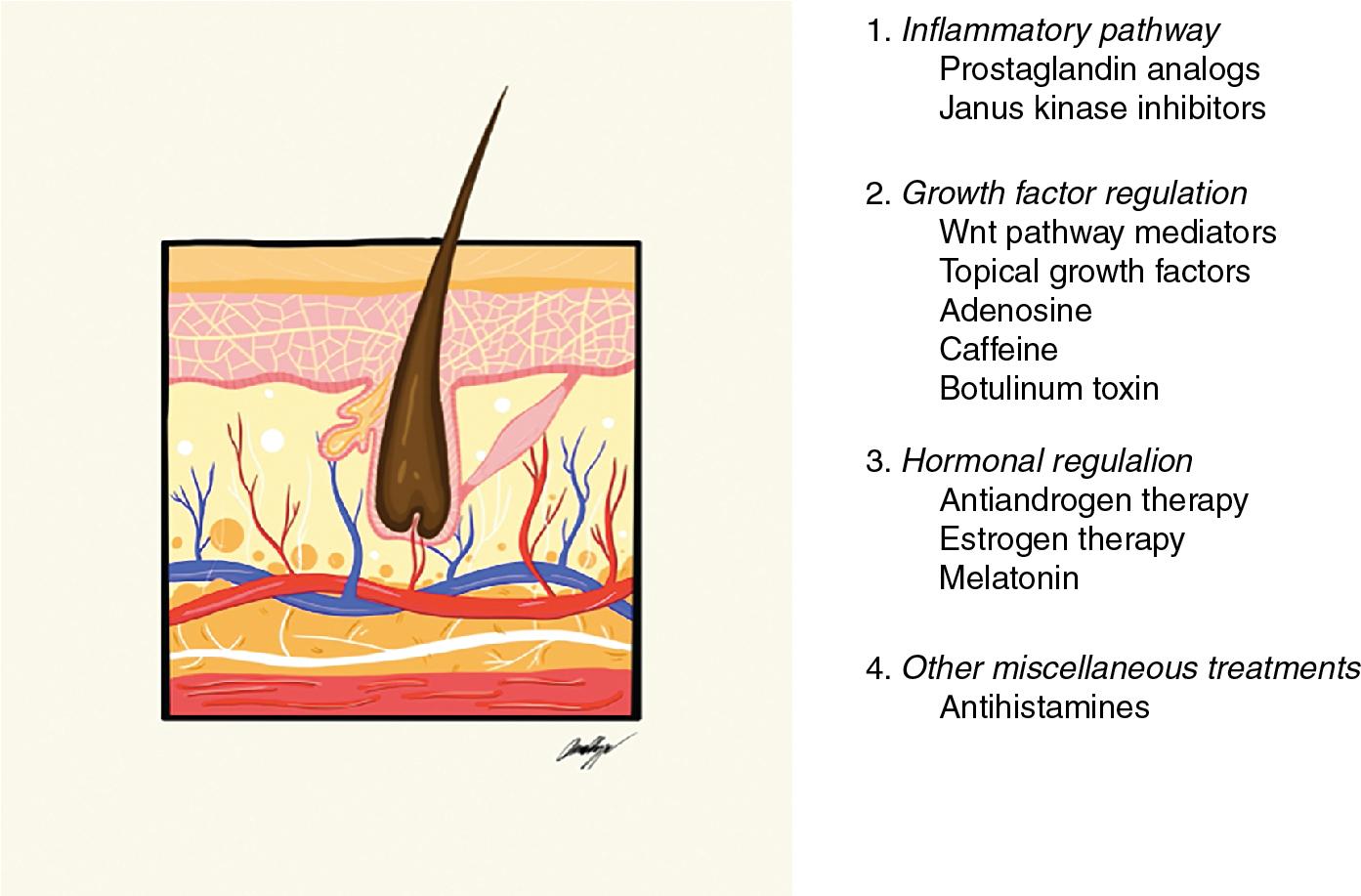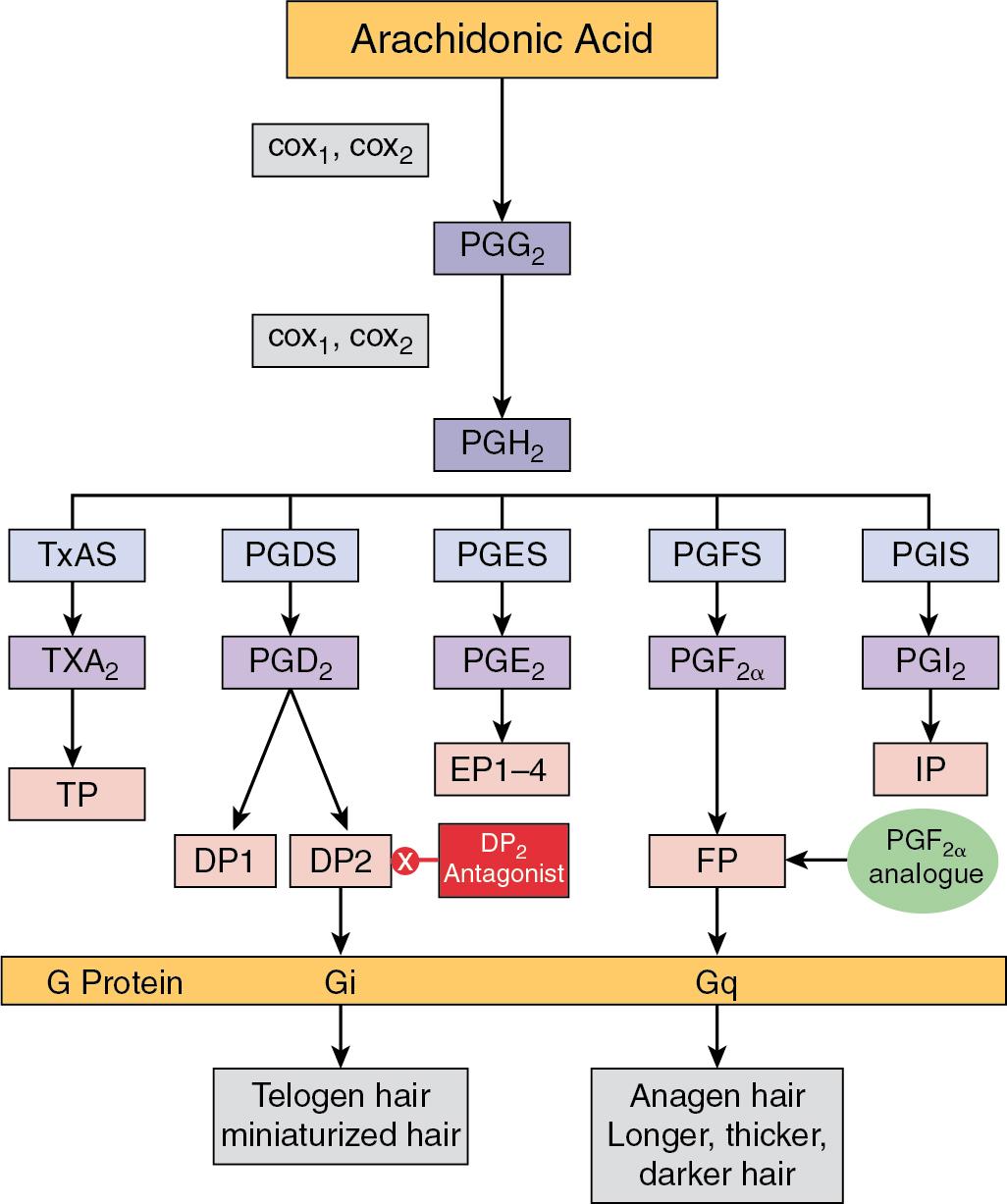Physical Address
304 North Cardinal St.
Dorchester Center, MA 02124
Topical prostaglandin analogs may increase vellus and terminal hair density and stimulate hair follicle activity.
Janus kinase inhibitors demonstrate great success in the treatment of alopecia areata, with potential for androgenetic alopecia.
Therapies targeting growth-factor regulation offer innovative options with success in androgenetic alopecia.
Antiandrogen therapy has a long history of investigation for therapeutic use androgenetic alopecia, and new topical therapies show promise.
Topical estrogen therapy is supported by several studies for the treatment of androgenetic alopecia, but conflicting reports exist.
Androgenetic alopecia (AGA) is a common age-dependent hair-loss disorder affecting more than 60% to 70% of men and women worldwide. The exact pathogenesis of AGA is not well understood, but genetic susceptibility and androgens are pivotal in predisposing individuals to pattern hair loss. There are currently only two pharmacologic treatments that the U.S. Food and Drug Administration (FDA) has approved for AGA: oral finasteride and topical minoxidil. Several new medical treatment modalities and pathways are being explored. Remarkable progress has been made in delineating novel signaling targets implicated in hair growth regulation, including pathways that upregulate key growth factors for germ-cell activation (Wnt mediators), reduce pathologic levels of androgenetic hormones (antiandrogen therapy), and reduce the level of inflammatory mediators (prostaglandins, Janus kinase [JAK] inhibitors). The scope of therapeutic options for AGA is rapidly expanding ( Fig. 16.1 ) with emerging treatments that hold promise for improved results.

Prostaglandins (PGs), a lipid-derived prostanoid family generated from arachidonic acid by cyclooxygenase (COX) isoenzymes, are known to variably modulate inflammatory responses. PG production typically increases significantly during acute inflammatory processes prior to leukocyte recruitment and immune cell infiltration. The most commonly bioactive prostaglandins implicated in regulation of the hair cycle with distinguishing effects include PGE 2 , PGF 2 α, PGD 2 , and prostacyclin (PGI 2 ) ( Fig. 16.2 ) (level of evidence: 5). PGE 2 and PGF 2α can prolong the anagen phase of the hair cycle, with studies showing that patients with AGA have reduced levels of PGE 2 . , PGE 2 acts as a direct vasodilator and suppressor of T-cell signaling and proliferation and can help reduce inflammation present in AGA. PGF 2 and its analogs stimulate follicular melanocytes and murine hair follicles in both the telogen and anagen phases.

In contrast, AGA scalps have increased levels of PGD 2 , a lipid synthesized via the COX and PGD 2 synthase pathways (PGDS) (level of evidence: 4). , PGD 2 acts as a proinflammatory mediator when released from mast cells and T helper (Th2) lymphocytes and has been implicated in the inhibition of hair growth. PGDS activity and PGD 2 levels increase prior to the catagen phase, suggesting their role in the cessation phase of the hair cycle. In murine models, elevated levels of PGD 2 induce follicle miniaturization, sebaceous gland hyperplasia, and alopecia (level of evidence: 5). , In human balding scalps, there are increased levels of PGD 2 , potentially caused by the upregulation of PGDS in comparison to normal scalps. PGD 2 stimulates the expression of androgen-receptor related genes in human dermal papilla cells (DPCs), such as transforming growth factor beta 1 (TGF-β1). New investigational medications targeting prostaglandin pathways are being explored for the treatment of AGA ( Table 16.1 ).
| Medication | Mechanism of Action | Route | Dose | Adverse Effects | Treatment Regimen |
|---|---|---|---|---|---|
| Latanoprost | PGF 2α analog | Topical | 0.1% solution | Eyelash hypertrichosis, malar vellus hair formation, erythema, folliculitis | Once daily |
| Bimatoprost | Synthetic PGE 2 analog | Topical | 0.03% solution | Eyelash hypertrichosis, malar vellus hair formation | Once daily |
| Setipiprant | Selective PGD 2 receptor antagonist | Oral | 500 mg | Gastrointestinal disorders, upper respiratory infection, liver enzyme abnormalities | Twice daily |
Topical prostaglandin analogs include latanoprost (PGF analog) and bimatoprost (synthetic prostamide F2 analog), which are eyedrops indicated for treatment of open-angle glaucoma. The stimulating effects of PGs on hair growth were first observed as a side effect, prompting further studies and eventual FDA approval of bimatoprost 0.03% solution for eyelash hypotrichosis. PG analogs interact with local receptors to extend the length of the anagen phase while simultaneously stimulating resting telogen-to-anagen hair follicles, with hair bulb and dermal papilla growth. The major reported side effects for both topical PG analogs include eyelash hypertrichosis and malar area vellus hair growth.
Bimatoprost (0.03% ophthalmic solution, Latisse, Allergan Inc., Irvine, CA) is a synthetic PGE 2 analog that increases the time hair follicles spend in the anagen growth phase. The initial excitement for its potential to grow scalp hair has thus far been supported by limited evidence, but clinical trials are still in progress at the time of publication. Studies suggest a concentration-dependent increase in the (a) number of anagen follicles and (b) follicular growth rates. Two large clinical trials evaluated the effect of topical bimatoprost on mean change in hair growth (mm/cm 2 ) from baseline compared with vehicle-treated groups in men with mild-to-moderate AGA after 24 weeks of treatment. Scalp application of topical bimatoprost 0.03% solution once or twice a day produced a 0.92 mm/cm 2 and 0.76 mm/cm 2 mean change in hair growth, respectively (level of evidence: 1b). However, another large clinical trial reported higher total hair counts with application of minoxidil 2% twice daily compared with once daily application of topical bimatoprost 0.03% among women with AGA after 6 months of treatment (level of evidence: 1b). Common adverse effects included application site pruritis and upper respiratory tract infections.
Latanoprost ( Xalatan, Pfizer, Inc.) is a PGF 2 analog currently approved by the FDA for the treatment of open-angle glaucoma and ocular hypertension. It acts as an inducer of the hair anagen phase, making it interesting for use in AGA. Evidence on the efficacy of compounded topical formulations, however, is lacking. A single clinical trial reported 16 men with mild AGA who were treated daily for 24 weeks with topical latanoprost 0.1% had a good clinical response and increased hair density compared with baseline (p<0.001) (level of evidence: 1b). Common adverse effects included erythema and folliculitis.
Setipiprant is a selective PG D2 receptor (PGD2R) antagonist that has been linked to the regulation of inflammatory pathways in asthma and allergies. At the time of publication, a clinical trial was underway to study the efficacy and safety of oral setipiprant 1000 mg twice daily relative to placebo in men with AGA (level of evidence: 1b). Results are eagerly awaited, as setipiprant has been shown to be well-tolerated and with a favorable safety profile for other indications.
JAK inhibitors are novel treatment options for alopecia area (AA) with therapeutic potential for other alopecia types. JAK inhibitors are a family of tyrosine kinases that mediate cytokine-receptor signaling through phosphorylation and activation of signal transducer and activator of transcription (STAT) nuclear proteins, which are critical for leukocyte activation and proliferation and play a major role in immune regulation. ,
Oral JAK inhibitors (e.g., baricitinib, ruxolitinib, and tofacitinib) are emerging as a favorable treatment modality for a variety of inflammatory conditions, with current FDA approval for myelofibrosis, rheumatoid arthritis, polycythemia vera, psoriatic arthritis, ulcerative colitis, and graft-versus-host disease. JAK-STAT inhibitors play a major role in hair regrowth by regulating T-cell mediated responses at the level of the hair follicle, affecting hair follicle growth and promoting anagen progression. ,
Topical JAK inhibitor preparations in AGA have resulted in anagen phase activation and rapid hair regrowth. Investigational topical JAK 1/3 inhibitor (ATI-50002, applied twice daily to scalp) effectively treated both women and men with AGA, with an increase of 8.6 hairs/cm 2 in total nonvellus hair count over 26 weeks and without any serious adverse events (level of evidence: 1b). However, oral JAK inhibitor treatments have not shown to be as effective for AGA thus far, as one study showed that, among men with AA with hair regrowth, the loss in AGA pattern was preserved. Similarly, in a later small observational study, men with severe AA on an oral JAK 1/3 inhibitor for 24 to 50 weeks experienced significant hair regrowth, but the AGA-pattern loss remained (level of evidence: 4).
Future studies are needed to address the conflicting results and determine the specific types of JAK inhibitors of use in AGA. As systemic JAK inhibition can have immunosuppressive properties, there is an inherent risk of increased infections (e.g., herpes zoster), laboratory abnormalities (anemia, leukopenia, elevated cholesterol levels), and potential risk for malignancy and thrombosis.
Become a Clinical Tree membership for Full access and enjoy Unlimited articles
If you are a member. Log in here